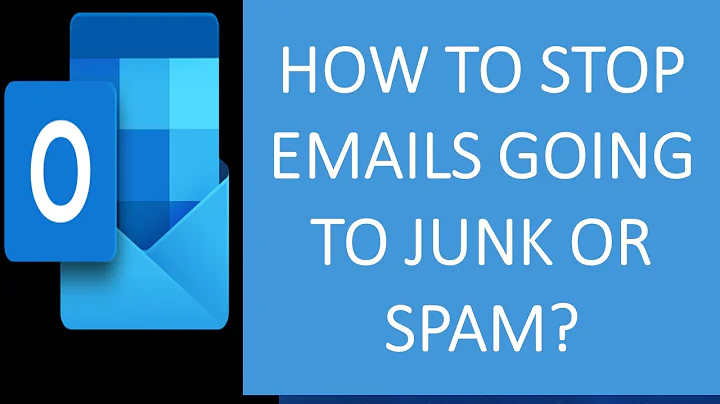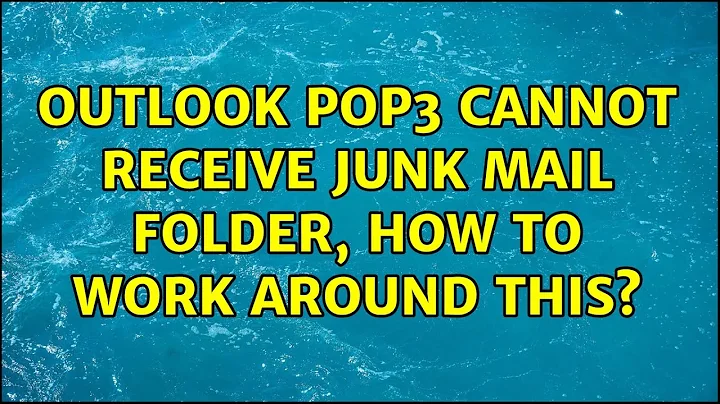Outlook POP3 cannot receive Junk mail folder, how to work around this?
POP3 does not have a concept of "folders" – when you log in, you only have access to one mail store, and that's usually the Inbox. It's really meant to be used in situations where the server does no sorting/filing at all – instead the client periodically picks up all incoming mail and sorts it into folders client-side.
If using POP3 is a requirement, see if you can tell the server not to create a "Junk Mail" folder at all. Most server-side spam filtering systems have the ability to add invisible headers indicating whether the message is spam or not (or sometimes even visible tags such as "Subject: [SPAM] google award"), and then you can have Outlook rules sort these messages into the local "Junk" folder.
I could change the protocol to IMAP, but then I'd have to find a way to make Outlook still appear to behave like a POP3 client. Employees keep upwards of 20GB of e-mails in their primary .pst file. I have no idea how this setup could translate to IMAP without being incredibly awkward to use. Our provider gives us limited serverside storage, so keeping it all serverside is not an option.
One cumbersome method would be to have Outlook rules automatically move all messages from IMAP folders into a local PST folder, while still keeping them marked as new. Your users would need to have IMAP configured but pretend it isn't there.
I could theoretically set up some kind of locally hosted e-mail storage or proxy service on our server, but I don't even know if such a thing exists. I definitely want to avoid running a full blown e-mail server and all the day-to-day hassles which come with that.
Yes, you could set up a regular IMAP server (e.g. Dovecot or Courier), plus a service (e.g. Fetchmail or Getmail) that downloads and deletes all messages from the original provider's server. Your users would keep all messages on your local server using IMAP, and your server would be able to sort them into folders.
You would likely need one instance of fetchmail/getmail per inbox, but it's easy to automate and a decent server should be able to handle it.
(It is not exactly the same thing as a "proxy", which generally means providing live access to the original server's data – just relaying the commands through – and that doesn't give you any advantages here.)
In fact, you might be able to arrange it with your provider to directly deliver all messages to your server via SMTP or some other mechanism, without the need to fetch each account.
Outbound mail can use your existing provider's SMTP servers directly, so you don't need to care about message delivery any more than you currently do.
Related videos on Youtube
theultramage
Updated on September 18, 2022Comments
-
 theultramage over 1 year
theultramage over 1 yearI have identified a misconfiguration in the way e-mail is set up at my workplace. We use POP3, and the accounts at our e-mail provider are set to move spam to a Junk mail folder. I have just learned that POP3 does not understand folders (only sees Inbox), so junk mail is never downloaded - all of it stays on the server until it is auto-deleted.
This explains why, for years, e-mail from customers would just not show up every now and then. Adding to the confusion, Outlook performs its own outdated non-bayesian filtering and does place things into the local spam folder, making it look like things are working as intended. I only discovered the issue after peeking into the serverside webmail interface.
So how do I remedy this situation without causing too much disruption?
I could change the serverside spam handling to 'place spam into Inbox', however I believe that would be the same as just turning serverside spam filtering off, defeating its whole purpose.
I could change the protocol to IMAP, but then I'd have to find a way to make Outlook still appear to behave like a POP3 client. Employees keep upwards of 20GB of e-mails in their primary .pst file. I have no idea how this setup could translate to IMAP without being incredibly awkward to use. Our provider gives us limited serverside storage, so keeping it all serverside is not an option.
I could theoretically set up some kind of locally hosted e-mail storage or proxy service on our server, but I don't even know if such a thing exists. I definitely want to avoid running a full blown e-mail server and all the day-to-day hassles which come with that.
None of these feel like the right solution, that's why I decided to ask here.
-
 Tetsujin over 4 yearsOutlook will behave as POP3 if that's how you access it [including that it doesn't constantly maintain its history online, only locally on the client. I've taken to periodically opening it on a web browser to check what it has mistakenly filed as spam. It will not forward it to my POP3 mail app until I've cleared it on the web interface.
Tetsujin over 4 yearsOutlook will behave as POP3 if that's how you access it [including that it doesn't constantly maintain its history online, only locally on the client. I've taken to periodically opening it on a web browser to check what it has mistakenly filed as spam. It will not forward it to my POP3 mail app until I've cleared it on the web interface. -
Seth over 4 yearsChange providers and protocols. Setup some Archiving solution if you really need to store mail locally. If by using the POP3 access mails are not presented to your client because they reside in a a different folder you won't be able to use POP3.
-
 theultramage over 4 yearsIf it were as straightforward as that, I wouldn't be asking. Nobody's going to give me 1TB of e-mail storage (not at a reasonable price, anyway), and storing that much sensitive customer communication off-premises at a discount ISP is probably a GDPR no-no. And just switching to IMAP would cause chaos, since now there'd be two inboxes to manage. Maybe with enough automation and UI fiddling it would work, but I doubt Outlook is that flexible (especially old versions of Outlook).
theultramage over 4 yearsIf it were as straightforward as that, I wouldn't be asking. Nobody's going to give me 1TB of e-mail storage (not at a reasonable price, anyway), and storing that much sensitive customer communication off-premises at a discount ISP is probably a GDPR no-no. And just switching to IMAP would cause chaos, since now there'd be two inboxes to manage. Maybe with enough automation and UI fiddling it would work, but I doubt Outlook is that flexible (especially old versions of Outlook). -
Appleoddity over 4 yearsUsing POP3 and storing emails in PST Files is like 1990’s technology. If your provider can’t offer a better service then that IS the problem. Switch to IMAP, change providers, or turn off spam filtering at the server level. Contrary to what you claim, there are multiple providers that do things right at very reasonable and acceptable costs. This is a business, you can get enterprise grade services from Office 365 for the equivalent of a few hours of payroll per user, per year. The idea of POP3 and storage limits in 2019 is silly, as is running your own mail server.
-
-
 theultramage over 4 yearsThank you. For now I will go with the first option, since it's the least invasive. I discovered that the ISP's spamassassin adds "X-Spam-Flag: YES", which is enough to make this work. Since it's an undisclosed implementation detail, I'll need to check every now and then if it's still working.
theultramage over 4 yearsThank you. For now I will go with the first option, since it's the least invasive. I discovered that the ISP's spamassassin adds "X-Spam-Flag: YES", which is enough to make this work. Since it's an undisclosed implementation detail, I'll need to check every now and then if it's still working.




